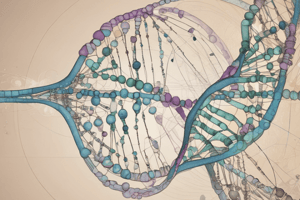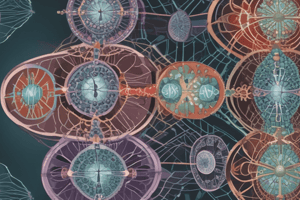Podcast
Questions and Answers
What effect does gene flow have on a population?
What effect does gene flow have on a population?
- It increases genetic variation in the population. (correct)
- It decreases the number of intermediate phenotypes.
- It reduces genetic variation within the population.
- It stabilizes the genetic traits of the population.
Which statement best describes natural selection?
Which statement best describes natural selection?
- It focuses on random mating within a population.
- It favors organisms with traits best suited for survival. (correct)
- It allows all traits to survive regardless of environmental factors.
- It ensures that offspring inherit all traits equally.
Which blood group genotype(s) possess the A antigen?
Which blood group genotype(s) possess the A antigen?
- IAIO (correct)
- IAIA (correct)
- IBIB
- I OI O
Which is the largest and most inclusive group in the Linnaean system of classification?
Which is the largest and most inclusive group in the Linnaean system of classification?
What type of inheritance occurs when both alleles are expressed equally in the phenotype of heterozygotes?
What type of inheritance occurs when both alleles are expressed equally in the phenotype of heterozygotes?
What is binomial nomenclature?
What is binomial nomenclature?
Who is known as the 'father of taxonomy'?
Who is known as the 'father of taxonomy'?
Which blood group has no antigens present on the red blood cells?
Which blood group has no antigens present on the red blood cells?
What is the smallest and most exclusive grouping in the Linnaean system?
What is the smallest and most exclusive grouping in the Linnaean system?
In terms of dominance, how are the A and B alleles related to the O allele?
In terms of dominance, how are the A and B alleles related to the O allele?
Which of the following best describes systems of classification?
Which of the following best describes systems of classification?
What is a characteristic of polygenic traits?
What is a characteristic of polygenic traits?
What phenotype results from incomplete dominance between two alleles?
What phenotype results from incomplete dominance between two alleles?
Which of the following statements about gene flow is false?
Which of the following statements about gene flow is false?
Which ABO genotype corresponds to type B blood?
Which ABO genotype corresponds to type B blood?
What defines codominance in blood types?
What defines codominance in blood types?
What is the primary limitation of the biological species concept?
What is the primary limitation of the biological species concept?
Which species concept is based on the idea of organisms sharing distinct characteristics?
Which species concept is based on the idea of organisms sharing distinct characteristics?
Which of the following groups of organisms can interbreed and produce fertile offspring according to the biological species concept?
Which of the following groups of organisms can interbreed and produce fertile offspring according to the biological species concept?
What defines the evolutionary species concept?
What defines the evolutionary species concept?
What is a characteristic of the typological/morphological species concept according to Aristotle?
What is a characteristic of the typological/morphological species concept according to Aristotle?
Which example illustrates organisms that look similar but belong to different species?
Which example illustrates organisms that look similar but belong to different species?
Which of the following statements is true regarding species that reproduce asexually?
Which of the following statements is true regarding species that reproduce asexually?
How do evolutionary biologists define a species according to their concept?
How do evolutionary biologists define a species according to their concept?
Flashcards
Species Concepts
Species Concepts
Different ways scientists categorize groups of organisms, based on shared characteristics, interbreeding potential, evolutionary history, or genetic relationships.
Typological/Morphological Species Concept
Typological/Morphological Species Concept
Species are recognized based on shared physical traits that distinguish them from other species.
Biological Species Concept
Biological Species Concept
Species are groups of organisms that can interbreed and produce fertile offspring.
Evolutionary Species Concept
Evolutionary Species Concept
Signup and view all the flashcards
Binomial Nomenclature
Binomial Nomenclature
Signup and view all the flashcards
Latin in Nomenclature
Latin in Nomenclature
Signup and view all the flashcards
Morphological Differences
Morphological Differences
Signup and view all the flashcards
Fertile Offspring
Fertile Offspring
Signup and view all the flashcards
Gene flow
Gene flow
Signup and view all the flashcards
Natural selection
Natural selection
Signup and view all the flashcards
Systems of Classification
Systems of Classification
Signup and view all the flashcards
Taxonomy
Taxonomy
Signup and view all the flashcards
Linnaean System
Linnaean System
Signup and view all the flashcards
Taxa
Taxa
Signup and view all the flashcards
Species
Species
Signup and view all the flashcards
ABO Blood Group
ABO Blood Group
Signup and view all the flashcards
Alleles for ABO Blood Type
Alleles for ABO Blood Type
Signup and view all the flashcards
Genotype vs. Phenotype
Genotype vs. Phenotype
Signup and view all the flashcards
Codominance
Codominance
Signup and view all the flashcards
ABO Blood Type: How Codominance Works
ABO Blood Type: How Codominance Works
Signup and view all the flashcards
Polygenic Traits
Polygenic Traits
Signup and view all the flashcards
Examples of Polygenic Traits in Humans
Examples of Polygenic Traits in Humans
Signup and view all the flashcards
Additive Effect of Alleles
Additive Effect of Alleles
Signup and view all the flashcards
Study Notes
DNA Structure and Properties
- DNA is the hereditary material in humans and almost all other organisms
- It carries the genetic material of an organism
- Most DNA is located in the cell nucleus, but a small amount is found in mitochondria (mitochondrial DNA) and chloroplasts
- The components of a nucleotide include a phosphate group, a pentose sugar (deoxyribose), and a nitrogenous base
Components of a Nucleotide
- Phosphate group: A phosphorus atom bonded with four oxygen atoms
- Pentose sugar (deoxyribose): A five-carbon sugar
- Nitrogenous base: A nitrogen-containing molecule; can be classified as either a purine (adenine, guanine) or a pyrimidine (thymine, cytosine)
The Nitrogenous Bases (DNA)
-
Classified into two groups
- Pyrimidines: Thymine and Cytosine
- Purines: Adenine and Guanine
-
Adenine pairs with Thymine (2 hydrogen bonds)
-
Guanine pairs with Cytosine (3 hydrogen bonds)
Salient Features of the Double-Helix Structure of DNA
- Composed of two polynucleotide chains
- Backbone is formed by sugar-phosphate units
- Bases project inwards
- Chains have anti-parallel polarity (5' to 3' and 3' to 5')
DNA Replication
- The process of producing two identical replicas from one original DNA molecule
- DNA replication is semi-conservative
- Each newly synthesized molecule contains one original "parent template" strand and one new "daughter" strand
Key Enzymes in DNA Replication
- Helicase: Unwinds the DNA double helix
- Primase: Provides the starting point of RNA
- DNA Polymerase: Adds new nucleotides to the 3' end of the elongating strand. It also proofreads and corrects errors.
- DNA Ligase: Re-anneals the semi-conservative strands and joins Okazaki fragments of the lagging strands
- Topoisomerase: Relaxes the supercoiled nature of the DNA
- Single-strand Binding Proteins (SSBs): Bind to ssDNA to prevent re-annealing after DNA helicase unwinds, maintaining strand separation
The Central Dogma of Molecular Biology
- A theory stating that genetic information flows in one direction from DNA to RNA to protein
- The steps of the process involve Replication, Transcription, and Translation
Transcription
- The process of synthesizing mRNA from DNA
- Involves the transfer of the DNA code to mRNA within the nucleus
Translation
- The process of reading the RNA sequence of an mRNA to create the amino acid sequence of a protein
Variations
- Naturally occurring genetic differences among individuals of the same species
Mendel's Laws of Inheritance
- Mendel's First Law (Law of Dominance): In a heterozygote, one trait will conceal another trait for the same characteristic.
- Mendel's Second Law (Law of Segregation): Alleles segregate from each other during gamete formation (meiosis) such that only one allele is present in each gamete.
- Mendel's Third Law (Law of Independent Assortment): Alleles of different genes are sorted independently into gametes.
- Monohybrid Cross: A cross between individuals heterozygous for a single trait (e.g., monohybrid cross for flower color).
- Dihybrid Cross: A cross between individuals heterozygous for two traits (e.g., dihybrid cross for seed color and seed shape).
Non-Mendelian Patterns of Inheritance
- Multiple Alleles: A single gene with more than two normal versions (e.g., ABO blood groups)
- Codominance: Both alleles for a gene are expressed equally in the phenotype (eg. AB blood type).
- Incomplete Dominance: The dominant allele is not completely dominant over the recessive allele; the resultant phenotype is intermediate (eg. pink flowers)
- Polygenic Traits: Traits controlled by more than one gene, with the alleles of each gene having a small additive effect on the phenotype (eg. human height).
- Pleiotropy: A single gene that affects multiple phenotypic traits.
- Epistasis: One gene influences/affects the expression of one or more other genes.
Earth's Origin
- Earth formed approximately 4.6 billion years ago
- Early Earth conditions were extremely harsh
- Constant bombardment from space debris
- Extremely high temperatures
- Toxic atmosphere (containing nitrogen oxides, methane, ammonia, and hydrogen sulfide) without much oxygen
- Frequent volcanic eruptions
- Intense lightning and radiation
Geologic Time Scale
- The geologic time scale (GTS) is a record of Earth's history and the order of life from 2500 Mya to the present
- It divides Earth's history into eons, eras, periods, and epochs
- The divisions are based on changes in life-forms over time
Early Invertebrates
- Cambrian Period (488-444mya) and Ordovician Period (448-444mya)
- Brachiopods, anomalocaris, pikaia gracilens were abundant
- The Ordovician period saw the appearance of many animals with jointed external skeletons, known as arthropods
Early Coral Reefs, Fishes, Vascular Plants
- Silurian Period (444-416 mya)
- Jawless fish, first known freshwater fish, vascular plants (Cooksonia)
- Devonian Period (416-359 mya)
- Placoderms (armored fishes), bony fishes (ray-finned fishes), lobe-finned fish, early vascular plants, lycophytes, horsetails, ferns
- First tetrapods (four-limbed vertebrates) and insects
Amphibians, Origins of Reptiles, First Seed Plants
- Carboniferous Period (359-299 mya):
- vast swamp forests, ferns, lycophytes, early amphibians, earliest reptiles
Reptiles (Dinosaurs), First Angiosperms, First Mammals
- Mesozoic Era (251-65.5 mya), Triassic, Jurassic, and Cretaceous Periods
- Marine reptiles, dinosaurs, first angiosperms (flowering plants), first mammals
Mammals
- Cenozoic Era (65.5 -present)
- First primates, rodents, apes, and humans
Evolution
- The change in heritable characteristics of biological populations over successive generations
- Natural selection is a key mechanism of evolution
Evidence of Evolution
- Direct (fossils):
- Fossils provide a record of how organisms have changed over time
- Indirect evidence:
- Comparative Anatomy
- Homologous structures, analogous structures, vestigial structures
- Molecular Biology
- Examining the similarities of biochemical molecules (DNA, ATP, amino acids, enzymes)
- Biogeography
- Studying the distribution of organisms
- Embryological Development
- Examining the similarities in the embryonic development of various organisms
- Comparative Anatomy
How evolution or change in gene pool occurs
- Nonrandom mating
- Mutation, changes in gene and chromosome composition
- Genetic drift, change in gene pool due to chance alone
- Gene flow, when individuals migrate from one population to another
Studying That Suits You
Use AI to generate personalized quizzes and flashcards to suit your learning preferences.
Related Documents
Description
Test your knowledge on genetics and classification concepts with this quiz focusing on natural selection, blood group inheritance, and Linnaean taxonomy. Questions cover key principles like gene flow, codominance, and patterns of inheritance. Perfect for students looking to review important biological concepts.




